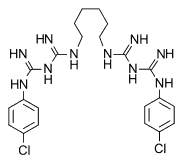SAN DIEGO -- Chlorhexidine was more effective than povidone iodine in sterilizing the vagina before hysterectomy in a small, randomized study.
"We can't say that using chlorhexidine would lead to a reduction in infections following vaginal hysterectomy, but I think we can say that it is more effective than povidone iodine in decreasing bacterial colony counts," Dr. Patrick Culligan said at the joint annual meeting of the American Urogynecologic Society and the Society of Gynecologic Surgeons.
"By my way of thinking, this interventional change would be no more expensive and no more time consuming, and it seems to make the vagina cleaner for surgery," Dr. Culligan said.
For the study, he and his associates randomized 50 women who underwent vaginal hysterectomy between October 2002 and September 2003 to receive a surgical scrub with either povidone iodine or chlorhexidine. Standard prophylactic techniques were used for both groups, including preoperative intravenous antibiotics, said Dr. Culligan of the division of urogynecology at the University of Louisville (Ky.) Health Sciences Center.
Investigators obtained aerobic and anaerobic bacterial cultures of the vaginal field from both groups preoperatively, 30 minutes after the surgical scrub, and hourly thereafter for each patient. Specimens were defined as contaminated if the total bacterial colony counts were at least 5,000 colony-forming units (CFU)/mL.
The mean preoperative colony count for the povidone iodine group was significantly higher, compared with the chlorhexidine group (211,975 vs. 172,296 CFU/mL). Thirty minutes after the surgical scrub, 63% of culture specimens from the povidone iodine group and 22% of the chlorhexidine group were contaminated. Ninety minutes after the surgical scrub that trend persisted, with 36% of the povidone iodine group and 14% of the chlorhexidine group classified as contaminated.
Limitations of the study include the fact that the clinical relevance of the end point of bacterial colony counts "may be in question," Dr. Culligan said. "You may ask, 'why wouldn't you just use infections as your end point?' We looked into that and [determined that] a study powered to detect the reduction of infection from say, 6% to 3%, would require greater than 800 patients in each arm. That's a tough study to do."
BY DOUG BRUNK
San Diego Bureau
COPYRIGHT 2004 International Medical News Group
COPYRIGHT 2004 Gale Group



